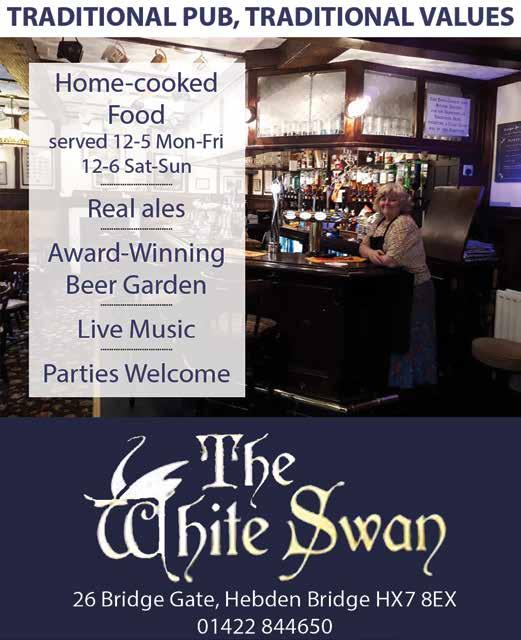
4 minute read
World of James Herriot - Explore & Discover
It’s easy to see why the World of James Herriot visitor attraction attracts visitors from all over the world. There’s so much to see and do here… It’s not just for fans of the books!
The 1940s home and surgery
Stepping through the famous red door of 23 Kirkgate, Thirsk is to step inside the World of James Herriot, the fully-restored site of his original 1940s home and veterinary practice (known in his books as Skeldale House, Darrowby) set in the heart of stunning Herriot Country.
The dining room and practice office
Explore this magical time-capsule, where the world’s most famous vet and one of the most popular writers of the twentieth century lived, worked and wrote his much-loved stories based on his experiences as a young veterinary surgeon working among the farming community of North Yorkshire. cinating ancient and bizarre remedies and the cramped and primitive consulting room that saw the treatment of many a poorly pet – only creatures small were dealt with by Alf in here!
Interactive Gallery
There’s no telling children ‘don’t touch’ in this gallery! Designed to engage children, young and old, the pieces use fun and interaction to educate visitors about farm animals and how they interact with our lives.
The home retains many of the original furnishings in the family rooms, frozen in time. The dining room doubled as the practice office, where farmers’ bills were typed up at the desk; the sitting room displays original books and family photos; the basement converted to an air raid shelter during the Second World War; the breakfast room favoured for its relative warmth and the reproduction of a typical farmhouse kitchen.
The original dispensary containing all potions great and small As well as a family home, it was also a busy surgery with a dispensary crammed with fas-
Full of fascinating facts, the gallery gives visitors the opportunity to test their skills, knowledge and reflexes whilst learning how vets work with farmers to keep animals fit and well. Not just for children!
There is one installation that TV viewers particularly will recognise and that’s the ‘not to be missed’ opportunity to place your hand up a cow’s bottom! An essential skill that every vet has to learn, All Creatures Great and Small actor Christopher Timothy famously did his part on several occasions, much to the amusement of the cast, crew and viewing public!
The World of James Herriot houses the largest collection of Herriot memorabilia in the world – from books, posters and letters to ornaments and collectables.
The Memorabilia Room is dedicated to displaying items that were instrumental in James Herriot’s writing career.
TV Studios
Take a close-up look behind the scenes of a reproduced set from the BBC series All Creatures Great and Small and experience the fascinating world of the TV studio and what was involved in the making of the TV program.
The latest addition to the centre’s collection is the original 1938 Austin Seven car, Registration JK 7443.
It appeared in the film “It Shouldn’t Happen to a Vet” with actor John Alderton as James Herriot, when it famously broke down in a river in the Yorkshire Dales.
Veterinary Science Rooms
There’s an incredible array too of veterinary paraphernalia from Herriot’s time as a young vet – in an era before advances in diagnostics, modern medicine and agricultural machinery. It is the largest collection in the world.
You can be the star of the show! Get in front of the camera and imagine yourself as Christopher Timothy playing James Herriot, Robert Hardy as the eccentric Siegfried Farnon, Peter Davison as Tristan Farnon, or Carol Drinkwater and Lynda Bellingham who both played James’ wife Helen Herriot. The series was a hugely popular show and had two runs from 1978 to 1980 (based directly on Alf’s books) and 1988 to 1990 (filmed with original scripts). The equipment on display shows just how far technology has moved on in TV and film, the huge cameras, endless cables, the intense heat from the lighting rigs all making life pretty uncomfortable for the actors involved.
The Austin Seven Car from ‘It Shouldn’t Happen to a Vet’
On display is a 4,000 piece archive showcasing veterinary instruments from the past to the modern day. These items chart the history and progress of the profession over the years. Some of the instruments appear primitive but were all designed for a particular purpose, since refined and updated for the modern vet’s practice.
The display reveals the close link with veterinary surgeons and the armed forces, from the days of the mounted cavalry and horses pulling gun carriages and supply wagons in warfare. Even today, ceremonial horses and battle-trained guard and sniffer dogs are the responsibility of the Royal Army Veterinary Corp, formed in 1796.
Foldyard and The Farrier’s Workshop
Much of Alf Wight’s work took place in farms all over North Yorkshire. To the rear of the house you will find the Foldyard and The Farrier exhibits, both with which Alf would have been very well-acquainted.
The Foldyard (described as an enclosure for sheep or cattle) houses a collection of primitive-looking hand tools in everyday use in farms before machinery appeared. In the hands of skilled workers, however, these tools were most effective. The Foldyard provides an authentic setting for visitors to watch an exclusive short film of Alf Wight, his family and friends and the cast of All Creatures Great and Small.
In the Farrier’s Workshop. the role of the farrier, which combines skills of both blacksmith and vet, is brought to life in this interesting exhibit. Before tractors and combine harvesters, farming relied on manual labour and what limited mechanisation existed was driven by horses. Farriers were an integral support to this system until the inevitable march of progress.
World of James Herriot Ltd, 23 Kirkgate, Thirsk, North Yorkshire,YO7 1PL Tel: 01845 524234









